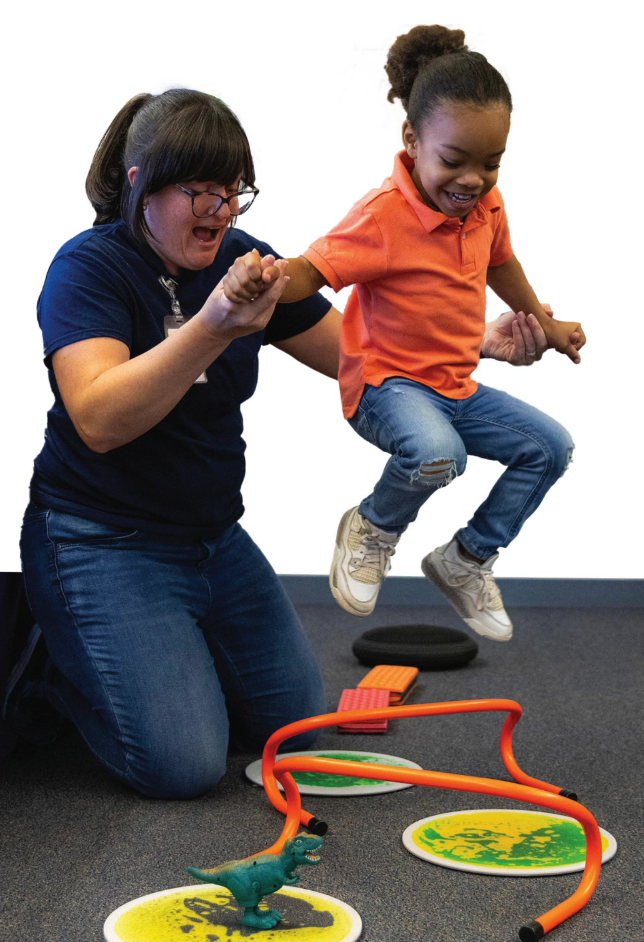
4 minute read
Sensory in Action: Integrating Sensory Strategies into Classroom Routines
By Emily Wiley
Sensory motor skills are the foundation for learning. We use our senses to interact with the world and understand our place in it. If a child struggles with sensory motor skills, it can affect their ability to focus, follow instructions, and keep pace with academic activities in the classroom.

The AIU’s Occupational and Physical Therapy (OT/PT) program director, Holly McElhinny, recognizes the importance of incorporating sensory into everyday school routines to support development. “As occupational and physical therapists, we understand that how a student processes sensory input can directly impact their success in the school environment,” she said.
By preschool age, the basic senses of sight, smell, hearing, taste, and touch have become more refined. Children can determine shapes, distinguish sounds, detect unpleasant smells and tastes, and follow directions like “jump on the purple tile.”
However, if one sensory motor skill fails to develop properly, the child may have difficulty learning. For example, a child who is overly sensitive to touch might have trouble holding a pencil or scissors. Or a child with visual tracking issues could struggle to follow a teacher’s instructions on the whiteboard or find it challenging to locate a hidden picture in a scene.
The OT/PT program identified a need to support sensory motor development in Preschool Early Intervention (PEI) classrooms. Christine Nypaver, clinical supervisor, said that previously, therapists provided services only to students in need. However, feedback from teachers indicated that all students could benefit from exposure to sensory activities.
“We listened to their feedback and integrated therapists into classrooms once a week as full instructional team members,” Nypaver said. “We also created the Sensory in Action program to support teachers with their classroom activities.”
Sensory in Action, which launched in September 2023, leverages evidencebased practices and research to incorporate sensory experiences into classroom routines. The program consists of three components: a newsletter that is shared with classrooms and families, activities that can be done at school and at home, and evidence-based practices that are used to train PEI teachers.

Kristen Morgan, PEI teacher in West Mifflin, said she is always looking for ways to address her students’ varying needs. “Some need to calm down and settle their bodies before they are ready to learn,” she said. “While others may need to move.”
This is why Sensory in Action offers a menu of activities to accommodate a range of students. “We give the teachers a toolbox with lots of options,” Nypaver said, “as opposed to saying, ‘this is exactly what you need to do for this student at this specific time of day.’”
Each Sensory in Action newsletter defines a sensory system focus, such as vision, touch, or movement. A corresponding activity bag is provided with resources like textured balls, bubbles, ribbon wands, balance disks, and whisper phones.

The third important aspect of the program is the research, training, and collaboration that happens between OT/PT clinicians and PEI teachers. Nypaver acknowledges that it is their job to educate and coach, not to dictate curriculum. “Sensory in Action is designed to complement classroom routines,” she said. “Our goal is to provide ongoing support to teachers and families.”
“The newsletters and activities give us teachers fresh ideas without having to search for or buy more materials,” Morgan said. “And when I see something is really effective or motivating for a child, I can coach the parents on how to do something similar at home.”
This coaching and collaboration model was on display during Sensory in Action’s recognition at the American Physical Therapy Association conference in November. Ginger Nese, clinical supervisor, said the program was positively received by colleagues. “During our presentation, we had the chance to engage with numerous school-based therapists from across the country. It was an excellent opportunity to discuss how we integrate sensory motor strategies into everyday routines to support therapy goals,” Nese said.
The team plans to use the Sensory in Action model to create a Movement Matters program with flexibility to address additional needs within PEI classrooms. “There are a lot of possibilities,” McElhinny said.










